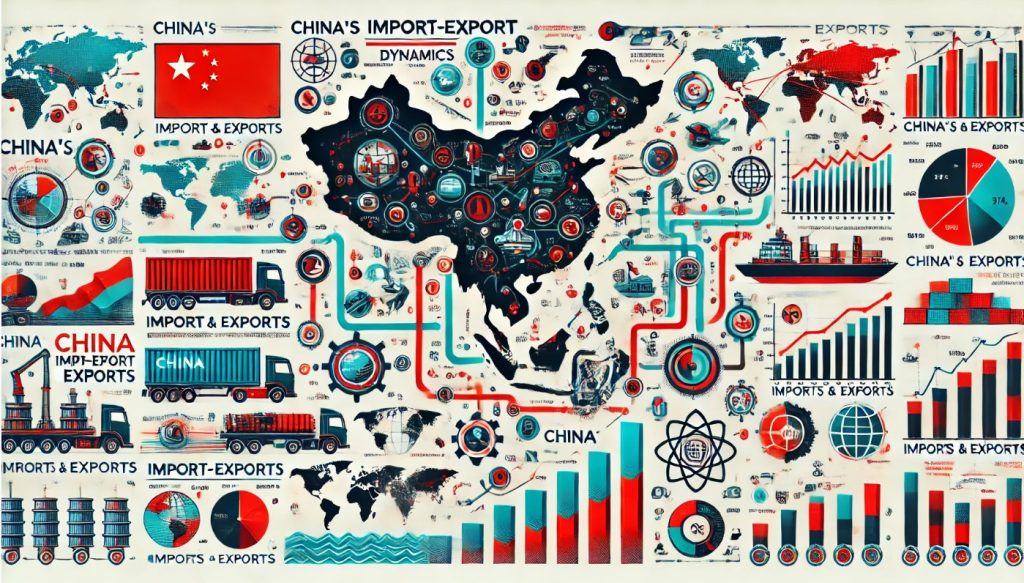China has transformed into the world’s largest exporter and second-largest importer, becoming a central player in the global economy. Since its opening up and reform period in the late 20th century, the country has integrated deeply into international trade networks. Its import-export dynamics have been crucial not only to its rapid economic growth but also to the shifting patterns of global trade. As the world’s largest manufacturing hub and a major consumer market, China’s import-export behavior impacts virtually every economy in the world.
China’s Export Powerhouse
The Evolution of China’s Export Sector
China’s export sector has undergone a remarkable transformation over the past few decades. In the late 20th century, China was primarily an agricultural and light manufacturing economy. However, since the 1980s, China’s shift toward an export-oriented growth model has turned it into the world’s factory, a position it solidified following its accession to the World Trade Organization (WTO) in 2001.
- Export-Oriented Economic Reforms: Starting with the Open Door Policy in the late 1970s under Deng Xiaoping, China introduced market-oriented reforms that encouraged foreign investment, technology transfer, and the expansion of export industries. The establishment of Special Economic Zones (SEZs), such as in Shenzhen, allowed foreign firms to set up manufacturing operations, often in collaboration with Chinese companies, facilitating export growth.
- Manufacturing and Industrialization: China’s rapid industrialization, especially in sectors like textiles, electronics, and machinery, has been a major driver of export growth. By focusing on labor-intensive industries, China capitalized on its vast workforce and low production costs, creating competitive advantages in global markets.
Key Export Products
China’s exports are diverse and span multiple sectors, reflecting the country’s growing industrial base and technological advancements. The country’s export portfolio is largely driven by manufactured goods, with the largest export categories being machinery, electronics, textiles, and chemicals.
- Electronics and Machinery: Machinery and electrical equipment, including computers, telecommunications equipment, and electronic components, are some of the largest export categories. China’s role as a global manufacturing hub for electronics has made it a key exporter of consumer electronics, including smartphones, televisions, and computers.
- Textiles and Apparel: China is the world’s largest exporter of textiles and apparel, accounting for a significant share of global garment exports. The country’s textile industry has grown rapidly due to cheap labor, a strong manufacturing base, and an ability to scale production.
- Chemicals and Pharmaceuticals: China is a major exporter of chemicals, including organic and inorganic chemicals, plastics, and fertilizers. The pharmaceutical industry has also seen rapid growth, with the country becoming a leading supplier of generic medicines and pharmaceutical raw materials.
Major Export Partners
China’s global export strategy has led to strong trade relationships with nearly every region of the world. However, its most significant trade partners remain Asia, Europe, and North America. These regions receive the bulk of China’s exports, particularly in high-tech and industrial products.
- United States: The United States has long been China’s largest single export destination, accounting for a substantial portion of its exports, particularly electronics, machinery, and textiles. Despite trade tensions and tariffs, the US remains an essential market for Chinese goods.
- European Union: The European Union is another major trading partner for China, particularly for products such as industrial equipment, machinery, and high-end consumer goods. Germany, the UK, and France are among the top importers of Chinese goods in the EU.
- ASEAN and Regional Partners: China’s relationship with countries in the Association of Southeast Asian Nations (ASEAN) has grown significantly, partly due to China’s growing presence in regional trade agreements like the Regional Comprehensive Economic Partnership (RCEP). ASEAN countries are important consumers of Chinese goods, particularly electronics and machinery.
Trade Surplus and Export-Driven Growth
China has historically run a trade surplus, with its exports significantly exceeding its imports. This surplus has been a key driver of the country’s economic growth. The trade surplus has allowed China to accumulate large reserves of foreign exchange, which have been used to fund infrastructure projects, foreign investments, and to stabilize the domestic economy.
- The Export Model of Growth: China’s export-driven growth model has been crucial to its rapid economic development. The revenue generated from exports has fueled investments in domestic infrastructure, education, and manufacturing capabilities, creating a cycle of growth that has made China an economic powerhouse.
- Global Supply Chain Integration: China is deeply integrated into global supply chains, with many countries relying on Chinese components and raw materials. This integration, particularly in industries such as electronics and automotive, ensures that China remains a critical player in global manufacturing.
China’s Import Landscape
Growth in Imports
While China has long been known as the world’s largest exporter, it has also become one of the world’s largest importers, especially in recent years. As China’s domestic consumption has increased, so too have its imports of raw materials, energy, and high-tech products. This shift reflects the country’s evolving economic model, which now emphasizes innovation, higher value-added industries, and consumer-driven growth.
- Increasing Domestic Consumption: The rapid expansion of China’s middle class and rising disposable incomes have spurred demand for a wide variety of goods, particularly consumer products, luxury items, and high-end technology. As a result, imports have surged, with China becoming a major market for foreign companies.
- Transition to a Consumer Economy: As China’s economy transitions from an export-led to a consumption-driven model, imports of consumer goods, especially luxury items, automobiles, and food products, have increased significantly. The growing middle class is increasingly turning to international brands for higher quality and variety.
Key Import Products
China’s imports are highly diversified, ranging from raw materials to advanced technology. The key categories of imports reflect the country’s needs to fuel its industrial production, meet domestic consumption demands, and advance its technological development.
- Oil and Natural Gas: As the world’s largest importer of crude oil, China has significant demand for energy resources. The country imports oil from countries like Saudi Arabia, Russia, and Angola, which is essential for its vast industrial base and growing demand for energy.
- Technology and Electronics: While China is a leading exporter of electronics, it remains heavily reliant on imports for certain high-end technology products. This includes semiconductors, integrated circuits, and other advanced components used in its electronics manufacturing industry.
- Automobiles and Auto Parts: China has become one of the largest importers of automobiles, especially luxury vehicles, from countries such as Germany, Japan, and the United States. Additionally, China imports a significant amount of auto parts to meet the demands of its own growing automotive manufacturing industry.
- Agricultural Products: China is the largest importer of agricultural products globally, including soybeans, grains, meat, and dairy products. The country’s growing population and urbanization have driven demand for food products, and China has become a key importer of agricultural commodities, particularly from countries like Brazil and the United States.
Major Import Partners
China’s imports come from a diverse range of countries, with significant contributions from developed economies and neighboring countries. Its top import partners include:
- South Korea and Japan: Both countries are key suppliers of advanced technology, machinery, and electronics. South Korea is a major source of semiconductors and display panels, while Japan exports high-quality machinery and automobiles.
- United States: The United States is a major source of high-tech products, agricultural commodities, and luxury goods. Despite trade tensions, China continues to rely on US imports, particularly for soybeans, aircraft, and medical devices.
- European Union: The European Union is an important supplier of automobiles, chemicals, and luxury goods. Germany, in particular, exports machinery, chemicals, and automobiles to China, while France and Italy are significant suppliers of luxury goods and agricultural products.
- ASEAN and Russia: China also imports raw materials and energy resources from its neighboring countries, especially oil and natural gas from Russia, as well as agricultural products from ASEAN countries.
Trade Imbalances and Structural Shifts
China has traditionally run a trade surplus, driven by its export dominance. However, in recent years, the country’s trade balance has become more complex. As China’s domestic consumption rises, imports have been increasing at a faster rate, reducing the country’s overall trade surplus.
- Trade Deficits in Certain Sectors: While China maintains an overall trade surplus, it runs trade deficits in certain sectors, particularly in high-tech goods. For instance, the country has a large trade deficit in semiconductors, which are crucial for its growing digital economy and electronics manufacturing sector.
- Shift Toward Quality Imports: As China’s economy matures, the focus of its imports is shifting from basic raw materials to higher-value goods, such as advanced technology, luxury consumer products, and services. This reflects a broader shift toward a consumption-driven economy.







